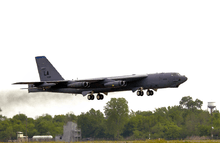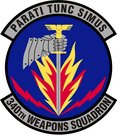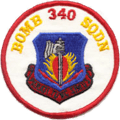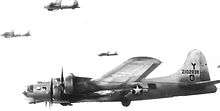340th Weapons Squadron
The 340th Weapons Squadron is a United States Air Force unit assigned to the USAF Weapons School. It is stationed at Barksdale Air Force Base, Louisiana. The 340th is assigned to the 57th Wing, at Nellis Air Force Base, Nevada. The mission of the squadron is to provide Boeing B-52 Stratofortress instructional flying.
340th Weapons Squadron
 | |
|---|---|
 Boeing B-52 taking off from Barksdale AFB | |
| Active | 1942-1945; 1946-1992; 2003-present |
| Country | |
| Branch | |
| Type | Squadron |
| Role | Advanced B-52 Stratofortress Training |
| Part of | USAF Weapons School |
| Garrison/HQ | Barksdale Air Force Base, Louisiana |
| Motto(s) | Parati Tunc Simus Latin Let Us Then Be Prepared[1] |
| Engagements | World War II
1991 Gulf War (Defense of Saudi Arabia; Liberation of Kuwait)[1] |
| Decorations | Distinguished Unit Citation (2x) Air Force Outstanding Unit Award (7x) |
| Insignia | |
| 340th Weapons Squadron emblem (modified from emblem approved on 16 March 1956)[1] |  |
| 340th Bombardment Squadron emblem (approved 16 March 1956)[2] |  |
| 340th Bombardment Squadron emblem (World War II)[3] |  |
On 3 February 1942, Captain Paul Tibbets (of Enola Gay fame) was given command of a new squadron that would later become the 340th Bombardment Squadron. The 340th Bomb Squadron was involved in combat missions in both the European and Mediterranean theaters from 1942 through 1945. The most notable of these were the Operation Tidal Wave raids on Hitler’s largest oil refinery in Ploiești, Romania. During the Vietnam War, B-52 crews from the 340th BS participated in the Linebacker offensives over the skies of North Vietnam. In August 1990 the 340th deployed aircrews for Operation Desert Storm.
History
World War II


Established in early 1942 as a Boeing B-17 Flying Fortress heavy bomb squadron; trained under Third Air Force in Florida. Deployed to European Theater of Operations (ETO) in mid-June 1942, being assigned to VIII Bomber Command in England. The squadron was one of the first B-17 heavy bomb squadrons in the ETO. During the summer of 1942, engaged in long range strategic bombardment of enemy military, transport and industrial targets, primarily in France and the Low Countries with limited fighter escorts.
Reassigned to the new Twelfth Air Force in England, being deployed to Algiers as part of the initial Operation Torch forces that arrived in North Africa. Squadron aircraft carried Triangle-O on tail. Engaged in bombardment of enemy targets in Algeria and Tunisia as part of the North African Campaign, and attacked enemy strong points around Tunis as part of the Tunisian Campaign. Continued heavy bomb missions of enemy targets in Sicily and Southern Italy and in late 1943 was reassigned to new Fifteenth Air Force formed in Southern Italy. From airfields around Foggia, conducted long-range strategic bombardment missions over Southern Europe and the Balkans of enemy targets until the German Capitulation in May 1945. Demobilized squadron personnel and aircraft were sent to the United States for reclamation in the fall of 1945; being inactivated in Italy in October.
Cold War
Reactivated in August 1946 under Strategic Air Command. Equipped with B-29 Superfortresses and participated in numerous exercises, operational readiness inspections, and overseas deployments. Became part of SAC nuclear deterrent force. Began upgrading to the new Boeing B-50 Superfortress, an advanced version of the B-29 in 1949. The B-50 gave the unit the capability to carry heavy loads of conventional weapons faster and farther as well as being designed for atomic bomb missions if necessary.
By 1951, the emergence of the Soviet Mig-21 interceptor in the skies of North Korea signaled the end of the propeller-driven B-50 as a first-line strategic bomber. Received B-47 Stratojet jet bombers in 1955 and despite initial difficulties, the Stratojet became the mainstay of the medium-bombing strength of SAC all throughout the 1950s, deployed frequently to North Africa and England for REFLEX exercises. Began sending its B-47s to AMARC at Davis-Monthan in 1959 when the aircraft was deemed no longer capable of penetrating Soviet airspace.
Reassigned to Blytheville Air Force Base, Arkansas and equipped with Boeing B-52G Stratofortress strategic bombers in 1960. Stood nuclear alert with the B-52G, although deployed aircrew to forward bases in the Western Pacific during the Vietnam War which flew Operation Arc Light and Linebacker I combat missions over Indochina; aircrews participated in the December 1972/January 1973 Linebacker II missions over the Hanoi-Haiphong area of North Vietnam. On 15 August 1973, after months of committing most of the wing's people and resources to the conflict, crew E-21 had the distinction of flying the last B-52 mission over a target in Cambodia. This marked the end of the United States' strategic bombing in Southeast Asia. Crews returned to the United States to training and alert status.
Deployed aircraft and crews to the 806th Bombardment Wing (Provisional) at RAF Fairford, England in February 1991, engaging in combat operations over Iraq and Kuwait during Operation Desert Storm. Inactivated in early 1992 after the end of the Cold War.
Bomber training
The Air Force Chief of Staff directed the creation of the 'B-52 Division, USAF Weapons School' on 1 October 1989 as the Strategic Weapons School, graduating the first class in April 1990. In 1992, with the activation of Air Combat Command, the B-52 Division was reborn as part of the USAF Weapons School, eventually becoming 'Detachment 2, USAF Weapons School. The 340th Bombardment Squadron was reactivated as the 340th Weapons Squadron, USAF Weapons School on 3 February 2003
Lineage
- Constituted as the 340th Bombardment Squadron (Heavy) on 28 January 1942
- Activated on 3 February 1942
- Redesignated 340th Bombardment Squadron, Heavy on 6 March 1944
- Inactivated on 29 October 1945
- Redesignated 340th Bombardment Squadron, Very Heavy on 15 July 1946
- Activated on 4 August 1946
- Redesignated 340th Bombardment Squadron, Medium on 28 May 1948
- Redesignated 340th Bombardment Squadron, Heavy on 1 October 1959
- Redesignated 340th Bomb Squadron on 1 September 1991
- Inactivated on 7 January 1992
- Redesignated 340th Weapons Squadron on 24 January 2003
- Activated and organized on 3 Feb 2003, assuming resources of B-52 Division, USAF Weapons School[1]
Assignments
- 97th Bombardment Group, 3 February 1942 – 29 October 1945
- 97th Bombardment Group, 4 August 1946 (attached to 97th Bombardment Wing after 10 February 1951)
- 97th Bombardment Wing, 16 June 1952
- 97th Operations Group, 1 September 1991 – 7 January 1992
- USAF Weapons School, 3 February 2003 – present[1]
Stations
- MacDill Field, Florida, 3 February 1942
- Sarasota Army Air Field, Florida, 29 March–16 May 1942
- RAF Polebrook (AAF-110),[4] England, 11 June–10 November 1942
- Maison Blanche Airport, Algiers, Algeria, c. 13 November 1942
- Tafaraoui Airfield, Algeria, c. 22 November 1942
- Biskra Airfield, Algeria, 26 December 1942
- Chateau-dun-du-Rhumel Airfield, Algeria, 8 February 1943
- Pont du Fahs Airfield, Tunisia, 12 August 1943
- Depienne Airfield, Tunisia, 14 August 1943
- Cerignola Airfield, Italy, c. 14 December 1943
- Amendola Airfield, Italy, 17 January 1944
- Marcianise Airfield, Italy, c. October–29 October 1945
- Smoky Hill Army Air Field, Kansas, 4 August 1946 (deployed to Mile 26 Airfield (later, Eielson Air Force Base), Alaska, 4 November 1947 – 12 March 1948
- Biggs Air Force Base, Texas, 17 May 1948
- Deployed to RAF Lakenheath, England, 5 March–4 June 1952; Andersen Air Force Base, Guam, 16 December 1953 – c. 15 Mar 1954
- Detachments at RAF Lakenheath, England, and Yokota Air Base, Japan, April 1954 – 1 April 1955
- Deployed to RAF Upper Heyford, England, 5 May–4 July 1956; Eielson Air Force Base, Alaska, 24 September – 2 November 1957
- Blytheville Air Force Base (later Eaker Air Force Base), Arkansas, 1 July 1959 – 7 January 1992
- Barksdale Air Force Base, Louisiana, 3 February 2003 – present[1]
Aircraft
- Boeing B-17 Flying Fortress, 1942–1945
- Boeing B-29 Superfortress, 1946–1950
- Boeing B-50 Superfortress, 1950–1954
- Boeing KB-29 Superfortress, 1954–1955
- Boeing ERB-29 Superfortress, 1954–1955
- Boeing RB-50 Superfortress, 1954–1955
- Boeing B-47 Stratojet, 1955–1959
- Boeing B-52 Stratofortress, 1960–1991[1]
See also
References
- Notes
- Bailey, Carl E. (August 22, 2008). "Factsheet 340 Weapons Squadron (ACC)". Air Force Historical Research Agency. Retrieved December 20, 2016.
- Maurer, Combat Squadrons, p. 421
- Watkins, pp. 72-73
- Station number in Anderson.
Bibliography
![]()
- Anderson, Capt. Barry (1985). Army Air Forces Stations: A Guide to the Stations Where U.S. Army Air Forces Personnel Served in the United Kingdom During World War II (PDF). Maxwell AFB, AL: Research Division, USAF Historical Research Center. Archived from the original (PDF) on 2016-01-23. Retrieved July 7, 2012.
- Maurer, Maurer, ed. (1983) [1961]. Air Force Combat Units of World War II (PDF) (reprint ed.). Washington, DC: Office of Air Force History. ISBN 0-912799-02-1. LCCN 61060979. Retrieved December 17, 2016.
- Maurer, Maurer, ed. (1982) [1969]. Combat Squadrons of the Air Force, World War II (PDF) (reprint ed.). Washington, DC: Office of Air Force History. ISBN 0-405-12194-6. LCCN 70605402. OCLC 72556. Retrieved December 17, 2016.
- Ravenstein, Charles A. (1984). Air Force Combat Wings, Lineage & Honors Histories 1947-1977. Washington, DC: Office of Air Force History. ISBN 0-912799-12-9. Retrieved December 17, 2016.
- Watkins, Robert A. (2009). Insignia and Aircraft Markings of the U.S. Army Air Force In World War II. Volume IV, European-African-Middle Eastern Theater of Operations. Atglen,PA: Shiffer Publishing, Ltd. ISBN 978-0-7643-3401-6.
